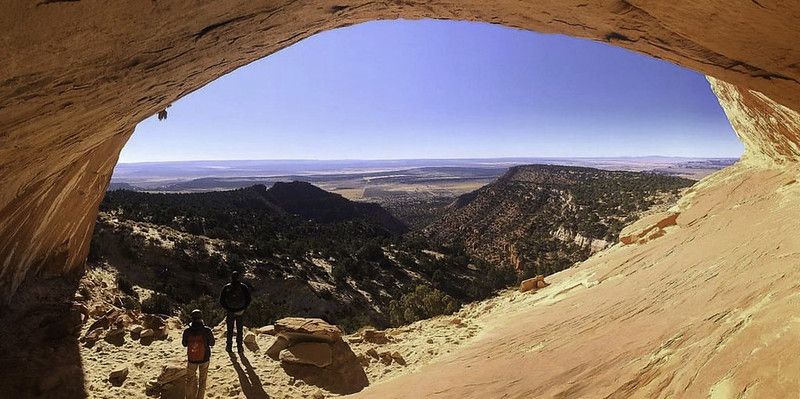The Public Lands Rule: Can conservation leasing mitigate impacts from energy and mining?
By Dustin Mulvaney | July 1, 2023
 Stretches of the Mojave Desert, Central Basin and Range, and the Colorado Plateau—each immense ecoregions that help define the West—converge in this landscape, with many plants and wildlife at the edges of their ranges. Plants exist here that are found nowhere else on earth. The BLM is investing in recreational services and restoration projects that increase water availability, address habitat fragmentation and restore riparian systems. BLM photo. (CC BY 2.0)
Stretches of the Mojave Desert, Central Basin and Range, and the Colorado Plateau—each immense ecoregions that help define the West—converge in this landscape, with many plants and wildlife at the edges of their ranges. Plants exist here that are found nowhere else on earth. The BLM is investing in recreational services and restoration projects that increase water availability, address habitat fragmentation and restore riparian systems. BLM photo. (CC BY 2.0)
The United States Department of the Interior’s proposed Public Lands Rule has been widely heralded as a conservation victory. The rule aims to protect intact landscapes and restore degraded habitat on public lands by allowing land to be leased for conservation purposes in the same way companies lease them for mining, grazing, and energy development. The rule seeks to “ensure healthy landscapes, abundant wildlife habitat, clean water and balanced decision-making on our nation’s public lands,” and if it goes through it would represent the biggest changes to public lands since the 1976 Federal Lands Policy Management Act.
The proposed rule comes at a time that renewable energy and critical mineral developers have their sites on public lands to provide domestic sources for the materials and energy for decarbonization. Public lands are managed for “multiple use and sustained yield” by the Bureau of Land Management (BLM). Overseeing 245 million acres of public lands or approximately 11 percent of all US land—plus another 700 million acres of subsurface minerals—the BLM is the nation’s largest landlord. Making balanced decisions on conservation and natural resource development has historically been a challenge for BLM, stemming from its origins as the US General Land Office and US Grazing Service. The agency has always lacked an organic act to give it an ultimate mission or sort through user conflicts, only the mandate codified in the Federal Lands Policy Management Act.
Numerous updates in the proposed rule will help the agency improve the integrity of the ecosystems they manage. Among them, the proposal could make it easier to nominate Areas of Critical Environmental Concern during land use planning. Given the extensive landscape this would affect, some wildlife and conservation organizations vocally support measures in the Public Lands Rule to bolster land protections, praising the idea that conservation would be treated as a “use” much as oil and gas, livestock, mining, and recreation are. Others say the rule makes only minimal changes to affect the ultimate causes of public lands degradation and is a lost opportunity to develop a coherent strategy to respond to natural resource development, climate change, and conservation challenges. Missing from the discussion is a critical examination of how the rule aims to change how developers offset impacts from energy and mining development.
When project developers cause impacts to BLM lands, the agency’s compensatory mitigation process requires they follow a mitigation hierarchy to avoid, minimize, or restore biodiversity impacts onsite; any onsite impacts that are unavoidable must be offset. The Public Lands Rule codifies the use of conservation leasing to mitigate environmental impacts of these types of projects. While there is nothing wrong in principle with acquiring and conserving land to offset negative impacts on other land, conservation leasing opportunities available from this rule will only be available on a fraction of public lands. Also, they do not result in conservation protections on private lands, like most mitigations do—even though sometimes the best habitat to mitigate an environmental impact sits on private lands.
Moreover, the public lands that are available for conservation leasing are already in conservation to some extent as they are ultimately managed by BLM and not slated for future energy or mining development. While investing in restoration at conservation leasing sites will surely improve habitat quality on those parcels, the best way to offset lost habitat is to add new protected habitat elsewhere.
Conservation leasing sounds like a win for conservation. Let conservationists compete with extractive industries to lease and restore public lands? It makes a lot of sense. On closer inspection, the conservation lands available to lease are more restricted than the full inventory of public lands. A conservation lease could not block an oil and gas lease for example. Climate activists could not bid against oil and gas developers for a parcel of land as was the case when conservationist and author Terry Tempest Williams tried to lease 1,120 acres of public lands in Utah to keep lands out of fossil fuel production. (The BLM ultimately denied the leases, contending that the Mineral Leasing Act requires lands for oil and gas be developed on a reasonable time scale, and that Williams had publicly vowed to leave hydrocarbons under the leased property in the ground.) Conservation leases would only be available in the Conservation Lands Program, or on other lands identified through BLM district offices. Furthermore, energy and mining developers are likely to be the biggest benefactors of conservation leases as they seek a “reliable path for compensatory mitigation” for impacts caused by their projects.
Compensatory mitigation is a type of biodiversity or conservation offset. When oil and gas companies develop sage grouse habitat, for example, they must offset the impacts by acquiring new habitat or investing in restoration, typically by protecting private lands and managing or restoring them. When a utility-scale solar farm proposes to develop on Mojave desert tortoise habitat, compensatory mitigation may require that the developer acquire habitat to replace it. Sometimes companies must protect more habitat than they are disturbing, creating multiple acres of new habitat to every one developed, depending on the species; for example, in California five acres of mitigation land is required for every one acre of San Joaquin kit fox habitat developed. To date only a few mitigations have occurred on public lands in the way the conservation leasing plan proposes. The Ivanpah Solar Electric Generating Station was built on public lands in California, and the compensatory habitat impact mitigation was to buy out the grazing allotments on nearby public lands.
As with carbon offsets programs, biodiversity offsets are rife with problems that undermine their effectiveness at achieving stated ambitions. One stipulated goal is that compensatory mitigation result in “no net loss” of habitat. But biodiversity offsets face the same challenges faced by offsets—are the benefits real, additional, and permanent? With the Ivanpah example, the benefit of grazing restrictions to landscape health was undermined by the fact the mitigation land habitat was inferior for the desert tortoise, compared to what was developed. So these mitigations were not real or impactful because they did not replace the habitat they disturbed.
In another case, a mitigation for a utility-scale solar project in Panoche Valley looked good on paper, with a mitigation ratio of 10 acres to every one developed. But the lands not only did not support the endangered San Joaquin kit fox habitat the project would disrupt, the BLM was already in talks to purchase the land prior to the proposed development. If the land was not under development pressure, it is hard to call these mitigations, in offset-speak, additional.
Finally, offsets are supposed to be permanent. The Public Lands Rule sets a limit of 10 years on conservation leasing contracts. The lease duration proposed does not correspond to the length of time it takes to conduct an ecological restoration and monitor results of a project in arid ecosystems, which can be difficult and have no guarantee of success. There are also some curious aspects of this policy, such as the possibility that conservation leasing could be used in tradeable carbon market offset schemes, which have been a disaster in other realms of energy and climate policy.
Compensatory mitigations that use public lands to offset development impacts to public lands were already codified in California under the Desert Renewable Energy Conservation Plan. A memorandum of understanding with the California Department of Fish and Wildlife allows solar developers to use public lands for compensatory mitigation activities such as restoration and habitat enhancement on BLM’s National Conservation Lands. The National Conservation Lands system is composed of 900 units and covers 35 million acres of the BLM real estate. These landscapes represent a small fraction of the federal lands managed by the BLM. This narrow scope means the proposed rule is missing important opportunities to acquire and restore habitat on private lands.
Public lands protect considerable biodiversity, provide habitat for endangered and threatened species, and support important ecosystem services, including carbon sequestration, across the western United States. A better plan to balance conservation and energy development would be to not develop important habitat in the first place. Our research with the Nature Conservancy found that mitigations can be avoided and environmental reviews altogether avoided by siting utility-scale solar projects on appropriate or compatible landscapes. According to Argonne National Labs, “good project siting, site preparation practices, and on-site best management practices can avoid many impacts (and thus avoid the need for CM [compensatory mitigations] and associated costs).” Where compensatory mitigations are required, they should result in no net loss of habitats that are impacted.
Public lands play a critical role in energy development and climate policy. The Department of the Interior’s oil and gas leasing programs on federal lands and waters supply 24 percent of US oil production and 11 percent of natural gas. For centuries public lands have been a source of fossil fuels and hard rock mining, and now they are being mobilized for climate action for renewable energy development, transmission corridors, critical minerals extraction, and sites of carbon sequestration and capture. Conservation leasing presents an opportunity to streamline renewable energy and transmission development, by making it clearer how impacts can be mitigated. But it is fair to be skeptical of the benefits of using conservation leases on public lands to offset the development of other public lands. Instead, compensatory mitigation policy for impacts of energy development should ensure there is “no net loss” and protect new landscapes—including private lands where there are few conservation protections today.
Editor’s note: Public comments on the Public Lands Rule are due July 5. For more information, see: https://www.blm.gov/public-lands-rule
Together, we make the world safer.
The Bulletin elevates expert voices above the noise. But as an independent nonprofit organization, our operations depend on the support of readers like you. Help us continue to deliver quality journalism that holds leaders accountable. Your support of our work at any level is important. In return, we promise our coverage will be understandable, influential, vigilant, solution-oriented, and fair-minded. Together we can make a difference.
Keywords: BLM, Public Lands Rule, conservation, enrvironmental mitigation, federal lands
Topics: Climate Change















